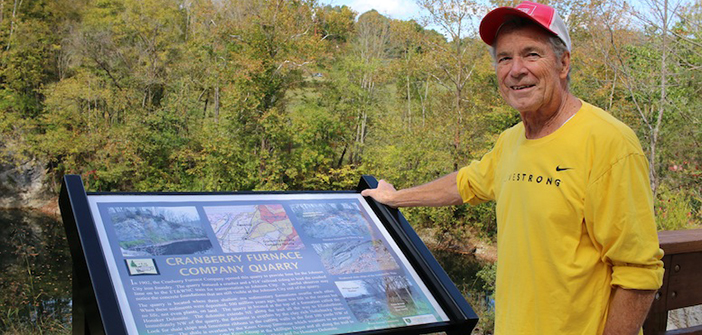
Cheri Tullis and Keith Edwards look at an interpretive sign explaining the varying
geological formations along the trail. Photos by Jeff Keeling
By Jeff Keeling
Cheri Tullis and Keith Edwards lingered Thursday afternoon at a colorful interpretive sign just across from the quarry near mile marker 3 of the Tweetsie Trail. The pair had plenty to see and read, as photos, illustrations and text told the story of the varying geological formations along the 10-mile trail.
Created by East Tennessee State University’s Department of Geosciences, the sign is one of a half-dozen in place near the Johnson City Noon Rotary’s gazebo and a collection of benches.
“I come here fairly often,” said Tullis, who lives in Bristol. “I love what the city of Johnson City has done with this trail.”
The latest endeavor was borne of a partnership between the trail task force and ETSU. Biology professor Dr. Fred Alsop is a task force member. When the idea of educational signage came up, he offered to enlist help from a variety of disciplines within the school.
The result so far? Signs educating trail users about the birds and trees of the trail (Alsop, an ornithologist, took the lead on the first); the “Story of the Tweetsie” and “Constructing a Mountain Railroad” (Appalachian Studies and the Department of Geosciences, respectively); and the geology and the “Cranberry Iron Furnace Company” (Geosciences).

Logan Hester, right, looks as Ken Moore points to a graph showing the various elevations traversed by the East Tennessee and Western North Carolina (Tweetsie) rail line.
“It seemed to me that we could interpret some of the birds that people see along the trails, and we could certainly look at some of the trees, and it just grew from there,” Alsop said.
“People are passing through a lot of unique geological formations, and there’s rich history there, too, so we decided to hit the biology, the geology and some of the historical information.”
Alsop had a student walk the trail for a year and see how many birds she could identify. The sign shows photos of 16. Botanist Tim McDowell gathered information on the two dozen tree species shown on that sign, complete with leaf/needle sketches. Professor Mick Whitelaw worked with geosciences students, and Ron Roach helped with the historical information.
“It all just seemed a natural extension of what the trail is bringing to the community,” Alsop said, adding that he hopes to see many more signs eventually, along the entire length from Johnson City through Elizabethton. They may also include QR codes allowing mobile phone users to access even more information online.
Where the trail crosses Buffalo Creek over an old railroad bridge (around mile marker 4), “there’s a lot of magnetic iron ore that came from the Cranberry mines and was dumped by the railroad to help stabilize the bridges,” Alsop said. “We’re planning on pulling some of that out and creating an exhibit that helps people understand, ‘here’s why the railroad was built in the first place, to transport these natural resources out of the mountains.’”
The existing signs are just shy of three miles from the trail’s Johnson City entrance at Legion and Alabama streets.

Two dozen tree species that exist along the trail are
identified in this sign researched by ETSU botanist
Tim McDowell.






